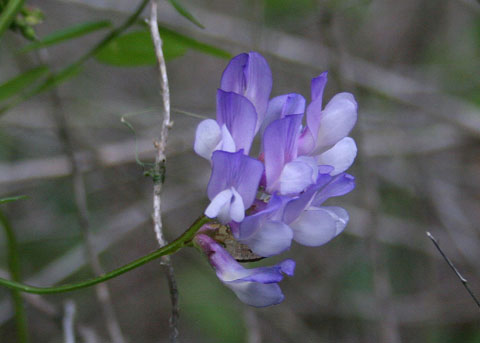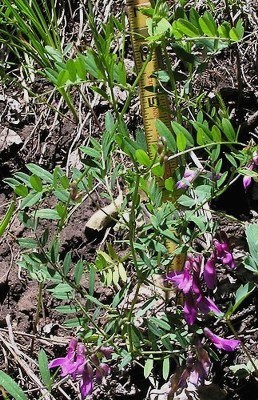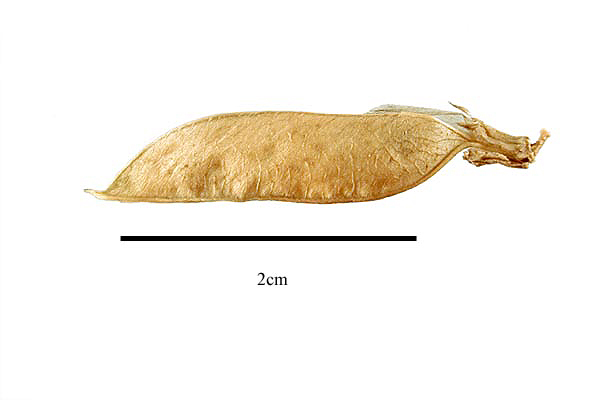 Download PDF
Download PDF
Name: Vicia americana Muhl. ex Willd.
Family: Fabaceae, the Pea family
Common Names: American Vetch (1)
Etymology: Vicia is Latin for the common name “vetch”. The species name “americana” indicates this type of Vetch is native to the Americas (3).
Botanical synonyms: None found in the literature.
Quick Notable Features:
¬ Terminal leaflet has a forked-tendril or bristle
¬ Completely herbaceous yet climbing up to 1 m
¬ Typically has 4-10 purple flowers per inflorescence
Plant Height: 20 to 100 cm in length (2).
Subspecies/varieties recognized: Vicia americana var. truncata (Nutt.) Brewer; Vicia americana var. angustifolia Nees (4).
Most Likely Confused with: Other legumes like: Vicia carolina, V. cracca, V. tetrasperma, and V. villosa. Phaseolus polystachios and P. vulgaris. Pisum sativum. Pueraria lobata. Strophostyles helvula. Wisteria fruescens and W. sinensis, Amphicarpaea bracteata, Apios americana, Desmodium rotundifolium. Lathyrus japonicus, L. latifolius, L. ochroleucus, L. palustris, L. pratensis, L. sylvestris, L. tuberosus, and L. venosus.
Habitat Preference: V. americana is commonly found in dry to moist areas, woods with swamps, forests, clear areas, canyons, and meadows. It prefers sandy soils and a variety of soils pH ranging from basic to acidic (5).
Geographic Distribution in Michigan: V. americana can be found throughout the lower and upper peninsulas of Michigan (1).
Known Elevational Distribution: The elevation distribution ranges from 1360 to 3180m in Utah (11).
Complete Geographic Distribution: V. americana is native to most of the continental United States, Alaska, and Canada. The exceptions are the southeastern states (Kentucky, North Carolina to Louisiana) and the New England states (Vermont to Maine). In Canada, it is found in every province except Nunavut, Newfoundland, New Brunswick, and Nova Scotia. In Mexico, it can be found in the states of Chihuahua, Mexico, and Morelos (1,5,12).
 Vegetative Plant Description: Vicia americana is a perennial plant. The compound leaves, from the base to the tendril, are commonly 7 to 9cm in length, typically glabrous and pinnate, have two sharp and serrate stipules at the base, 4-8 leaflet pairs, which vary in pubescence presence and shape. The leaflets are usually entire (rarely toothed). The leaflets are 1.2 to 1.4cm wide and 2.5 to 3cm long. The secondary veins are “rib-like” and prominent. The stem can climb up to 100cm. The taproot’s depth can reach down to 100cm (1,2,4,13, and 14 (cited in 15)).
Vegetative Plant Description: Vicia americana is a perennial plant. The compound leaves, from the base to the tendril, are commonly 7 to 9cm in length, typically glabrous and pinnate, have two sharp and serrate stipules at the base, 4-8 leaflet pairs, which vary in pubescence presence and shape. The leaflets are usually entire (rarely toothed). The leaflets are 1.2 to 1.4cm wide and 2.5 to 3cm long. The secondary veins are “rib-like” and prominent. The stem can climb up to 100cm. The taproot’s depth can reach down to 100cm (1,2,4,13, and 14 (cited in 15)).
Climbing Mechanism: V. americana uses the tendril of its terminal leaflet to climb (2).
Flower Description: The inflorescence has 4 to 10 purple hermaphroditic flowers, each about 15 to 25mm in length. Each flower has a five-toothed calyx tube 3.5 to 5.5mm in length sometimes reported as somewhat gibbous at the base, a 15 to 25mm long bluish-purple corolla, 10 stamens, and an ovary composed of 1 superior pistil with 1 stigma (2,4,8,9,17,20).
 Flowering Time: Vicia americana commonly blooms from May to July (7).
Flowering Time: Vicia americana commonly blooms from May to July (7).
Pollinator: Bumblebees are reported to pollinate the flower (16).
Fruit Type and Description: The glabrous or hairy fruit is a legume and typically 25 to 35mm long, each containing 8 to 14 seeds. The pods dehisce when they are ripe (2,4,9,19).
Seed Description: The subglobose seeds are 3 to 4mm in length (4).
 Dispersal Syndrome: Not found in the literature.
Dispersal Syndrome: Not found in the literature.
Distinguished by: Lathyrus leaflets are typically wider in proportion to their length than Vicia’s leaflet proportions. Desmodium, Phaseolus, Amphicarpaea, and Strophostyles have 3 leaflets while Vicia has 2, 4, or more leaflets. Pisum has longer and wider stipules than its lowest leaflets while Vicia has smaller stipules than its lowest leaflets. Wisteria is a woody vine while Vicia is herbaceous. Apios has a developed terminal leaflet while Vicia has a terminal leaflet commonly represented by a forked-tendril or bristle, and Pueraria leaflets have no tendril (1,2).
Other members of the family in Michigan: Wisteria (1), Amorpha (2), Amphicarpaea (1), Anthyllis (1), Apios (1), Astragalus (3), Baptisia (4), Caragana (1), Cercis (1), Chamaecrista (2), Cladrastis (1), Colutea (1), Crotalaria (1), Cytisus (1), Dalea (1), Desmodium (12), Genista (1), Gleditsia (1), Glycine (1), Gymnocladus (1), Hedysarum (1), Kummerowia (1), Lathyrus (10), Lespedeza (13), Lotus (1), Lupinus (2), Melilotus (2), Mimosa (1), Orbexilum (1), Phaseolus (2), Pisum (1), Pueraria (1), Robinia (3), Securigera (1), Senna (1), Strophostyles (1), Tephrosia (1), Trifolium (9), Vicia (7), Vigna (1) [1].
Ethnobotanical Uses: American Vetch can be used to revegetate slimmed conifer or burnt areas. Native Americans eat the seeds and seedpods. The crushed and brewed leaves can be applied during baths to treat soreness and can treat spider bites (5,6).
Phylogenetic Information: Vicia americana is a member of the Fabaceae, subfamily Faboideae. Families Fabaceae. Polygalaceae, Quillajaceae, and Surianaceae form the Fabales order. The Fabales, Rosales, Cucurbitales, and Fagales form a monophyletic group within the Eurosids I within the larger Rosid group. All are eudicots are angiosperms (11).
Interesting Quotation or Other Interesting Factoid not inserted above: Native American women have used the brewed leaves as a medicine for love (6).
Literature and websites used:
- Voss, E. G. 1985. Michigan Flora Part II. Ann Arbor, Michigan, USA: University of Michigan Press.
- McGregor R. L. and T. M. Barkley. 1986. Flora of the Great Plains. Lawrence, Kansas, USA: University Press of Kansas.
- Brown, R. W. 1956. The Composition of Scientific Words. Washington, D. C., USA: Smithsonian Institution Press.
- Fernald, M. L. 1970. Gray’s Manual of Botany. New York, New York, USA: Van Nostrand Publishing
- USDA, ARS, National Genetic Resources Program. Germplasm Resources Information Network – (GRIN) [Online Database]. National Germplasm Resources Laboratory, Beltsville, Maryland. http://www.ars-grin.gov/cgi-bin/npgs/html/taxon.pl?41449
- Moerman, D. E. 1998. Native American Ethnobotany. Oregon, USA: Timber Press. http://www.ibiblio.org/pfaf/cgi-bin/arr_html?Vicia+americana
- Gleason, H. A. 1968. The New Britton and Brown Illustrated Flora of the Northeastern United States and Adjacent Canada Vol 2. New York, USA: Hafner Publishing Company, Inc.
- Plants for a Future, 1996-2003. http://www.ibiblio.org/pfaf/cgi-bin/arr_html?Vicia+americana
- Hickman, J. C. 1993. The Jepson Manual: Higher Plants of California. Berkeley, California, USA: University of California Press.
- Ramsey. R. D. Digital Atlas of the Vascular Plants of Utah. http://www.gis.usu.edu/Geography-Department/utgeog/utvatlas/family/faba2/viam.html
- ANGIOSPERM PHYLOGENY GROUP 2003. An update of the Angiosperm Phylogeny Group classification for the orders and families of flowering plants: APG II. Botanical Journal of the Linnean Society 141(4):399-436.
- USDA Plants Profile, http://www.nrcs.usda.gov/
- Wasser, C. H. 1982. Ecology and Culture of Selected Species Useful in Revegetating Disturbed Lands in the West. Washington DC, USA: Department of the Interior, Fish and Wildlife Service.
- Wooley, S.B. compiler. 1936. Root Systems of Important Range Plants of the Boise River Watershed: A Catalogue of Species Excavated by Liter E. Spence, collaborator. Unpublished paper on file at: US Department of Agriculture, Forest Service, Intermountain Fire Sciences Lab, Missoula, Mt. p. 59.
- Coladonato, M. 1993. Vicia americana. In: Fire Effects Information System, [Online]. U.S. Department of Agriculture, Forest Service, Rocky Mountain Research Station, Fire Sciences Laboratory (Producer). http://www.fs.fed.us/database/feis/ [2008, January 29].
- Inouye, D. W. 1980. The effect of proboscis and corolla tube lengths on patterns and rates of flower visitation by bumblebees. Oecologia 45(2): 197-201.
- Bartlett, G. 1914. The Native and Cultivated Vicieae and Phaseoleae of Ohio. The Ohio Naturalist 15(2): 393-404.
- The PLANTS Database: USDA, NRCS, 1991-2007. http://plants.usda.gov/java/profile?symbol=WISI
- Burton, C.M. and P.J. Burton. 2003. A Manual for Growing and Using Seed from Herbaceous Plants Native to the Northern Interior of British Columbia. Smithers, BC, Canada: Symbios Research & Restoration.
- Hitchcock, C.L. and A. Cronquist. 1973. Flora of the Pacific Northwest. Seattle, Washington: University of Washington Press.
- Kirkbride, J.H., Jr., C.R. Gunn, and M.J. Dallwitz. 2006. Family Guide for Fruits and Seeds, vers. 1.0. URL: http://nt.ars-grin.gov/sbmlweb/OnlineResources/frsdfam/Index.cfm. Accessed October 3, 2009.
Image Credits (all used with permission):
1) The inflorescence close-up is courtesy of Joan Avise from http://nathistoc.bio.uci.edu/plants/Fabaceae/Vicia%20americana.htm
2) The leaf close-up is copyright Al Schneider, http://www.swcoloradowildflowers.com/
3) The flower close-up is courtesy of Mary Ellen (Mel) Harte, Bugwood.org as displayed on www.forestryimages.org
4) The fruit close-up is courtesy of Robert J. Gibbons from reference 21
Primary Authors: Jacob T. Bowman with editing by Robyn J. Burnham
© Robyn J. Burnham, University of Michigan
For additional information on Michigan Plant Diversity web pages please contact Robyn J. Burnham via email: rburnham“at”umich.edu